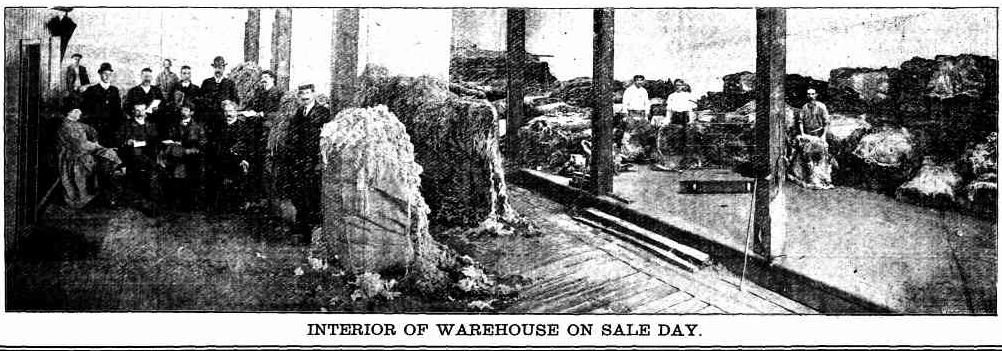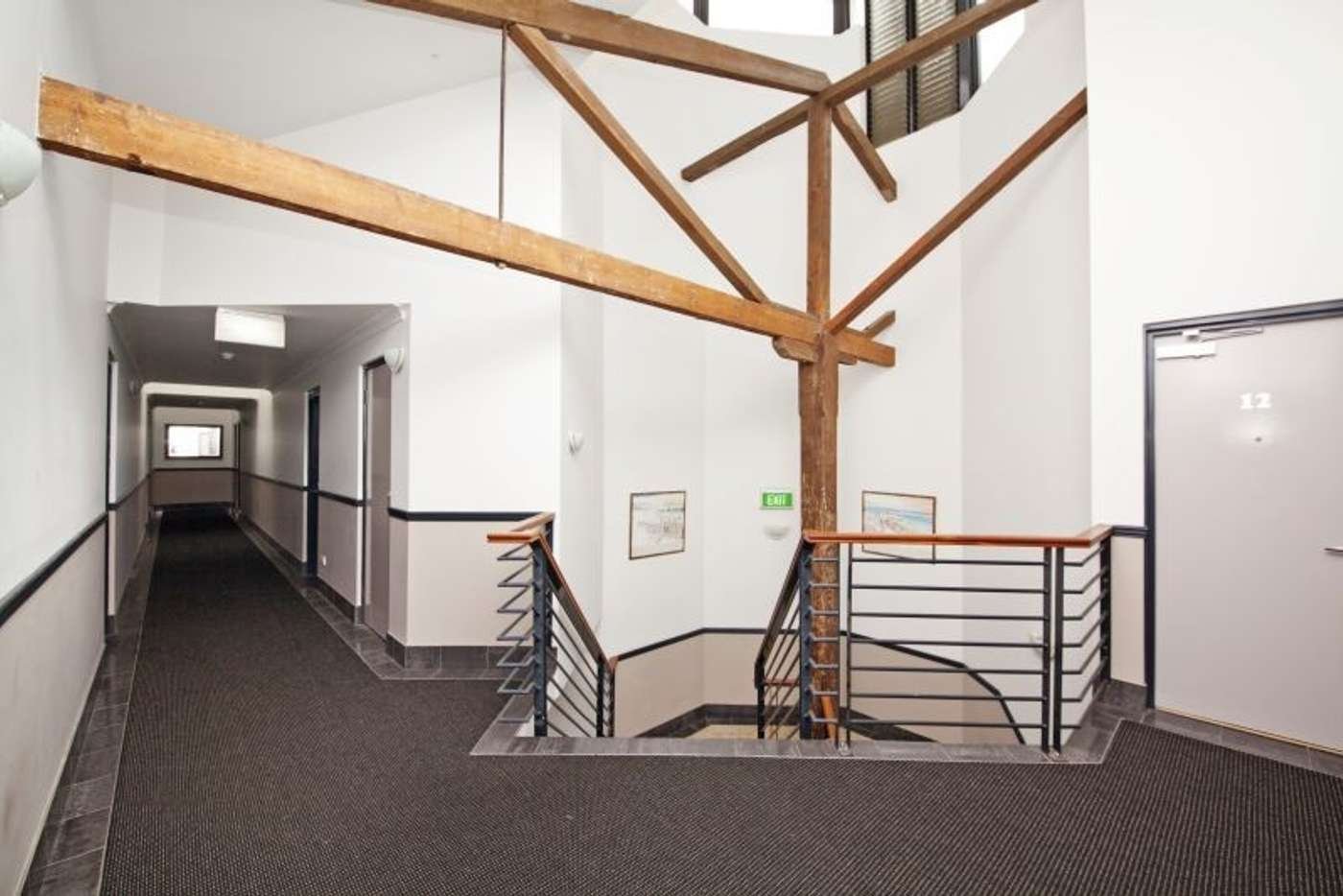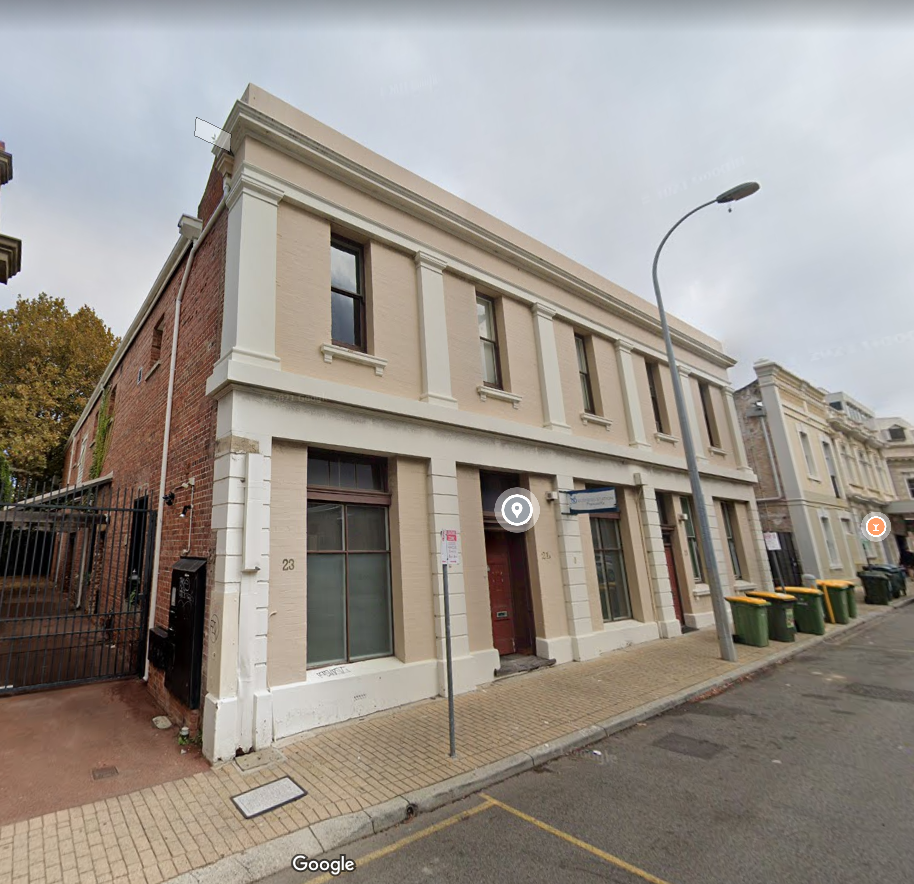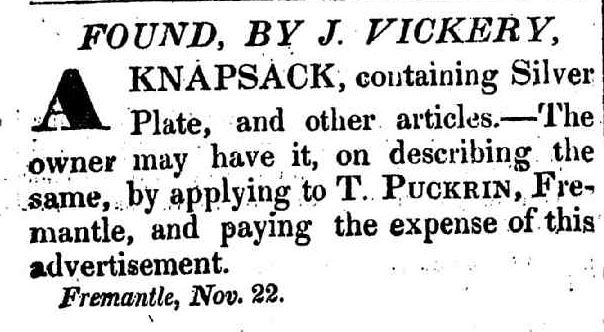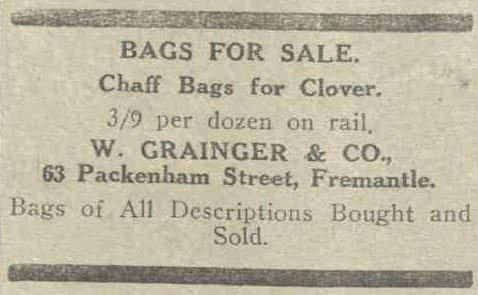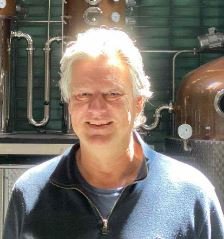32 Pakenham Street (pre 1938 - 62 Pakenham Street), Chinese laundries,
From 1903- 1940 there were Chinese laundries on this site. The first Chinese commercial laundries were probably established in the late 1880s. There is a report of a 22 year old Chinese man employed in the Ying Lee Laundry in Market Street, Fremantle, in 1891 (reference Atkinson p 219). This laundry (aka Yeong Lee/Young Lee) operated at no 48 (now 42) Market St until 1900 when it continued up the road at no 39 (now 31) Market St, near other Chinese owned buildings. In 1893 Yeong Lee (from San Francisco) also opened a laundry in 64 (35) Packenham St (reference) and in 1903 there was a Chinese Laundry on Hampton Road, Beaconsfield. (reference)
From at least 1985 there were two or three terrace houses at 62-66 (now 32-35) on the corner of Packenham and Bannister Streets, which incorporated Chinese shops and laundries. They shared a common backyard and variously contained laundries run by Hong Wah (1902-1928), Cheong Lee (1929-1941) and a Japanese brothel (c 1902-1917) (reference)
Hong Wah from 1903 - 1928
In 1889 ‘Hang War’ had a laundry in Murray St, Perth (reference) In 1902 Hong Wah applied for a licence to open a laundry in North Fremantle. This was initially refused by the Council Health Committee-with no explanation given. (reference)
By October 1902 Hong Wah had opened a laundry in Packenham St. It cant have been easy- an incident in Perth in 1893, where a ‘practical joke’ had been played on Sam Lee’s Chinese Laundry (an official yellow streamer bearing in large black letters the word ‘‘smallpox’ had been pasted on his window), highlighted the harassment Chinese laundries faced. (reference) They were an easy target for drunken men and bullies, and were rarely protected by the courts:
Oct 1902, CHINESE LAUNDRY RANSACKED. Before the Fremantle Police Court this morning, Richard Williams was charged with stealing two parcels containing clothing from Hong Wah, a Chinese laundryman. The accused stole into the plaintiff's premises in Packenham-street and ran off with two parcels in which were newly-washed clothes. The accused said he did not know anything about the affair, and would therefore be obliged to plead guilty. "It must have been a drunken lark," said the accused, " for I would never think of doing such a thing in my right senses." (reference)
Dec 1903 A Drunken Freak. In the case of David Buckley (37), who was charged with being unlawfully on the premises of Hong Wah, it was shown that the man was intoxicated, and, apparently, not responsible for his actions. He was discharged with a caution. (reference)
1904 ‘Celestial Laundryman in Trouble’. Hong War, a Chinese laundryman was charged with having unlawfully detained various articles of clothing valued at 15s. 6d., the property of T. Aldridge. Accused, through an interpreter; pleaded not guilty. The complainant stated that the accused called at the Madrid Restaurant and was given the articles mentioned in the information to wash. On the following Saturday he called with a parcel which contained clothing that did not belong to witness. The defendant told the Court that he had not made any mistake. but the Bench found in favour of the complainant, and. in imposing a fine of 13s. 6d. with costs, advised the defendant to adopt some better system for distinguishing the various parcels. (reference)
Despite racism and being treated unequally by some, the Chinese community tried to participate in WA society. in 1905 Hong Wah with other members of the Chinese business community contributed funds towards the new Perth Public Hospital ( reference)
1907 At a meeting of the Fremantle Local Board of Health a report on the condition of premises in the town was submitted by the Health Officer (Dr. J. W. Hope) and the Health Inspector (Mr. T. Wilkinson). It included a description of ‘‘Pearse's Buildings’’- Laundry occupied by Hong Wah, living-room very dirty. Dirty habits of occupants. Floors of the whole of these need raising to level of street. This is in consequence of raising for drainage purposes of the yard being provided. House in this block at corner of Packenham and Bannister streets needs ventilation.” (reference)
The impact of the racist White Australia Policy- so prevalent in 1910 can be seen in the responses to a report from Dr. Owen Paget, the Fremantle Municipal Medical Officer;
"I desire to draw your attention to the various Chinese laundries in the municipality. These businesses are in many cases carried on in unsuitable buildings, often only having a small yard area for drying, and the disposal of waste water. Usually these waters are discharged into the jarrah storm water channels or drains to which attention was drawn in my yearly report. A further objection is the face that most of these premises are kept in a state of semi-darkness by means or blinds, painted windows, etc. The windows, too, seem to be rarely if ever open. Sunlight and fresh air are powerful disinfectants, and it is not right that soiled linen from possibly infectious cases should be kept in a haphazard or insanitary manner. Further, the habit of Chinese laundrymen when ironing of sprinkling the clothes with water held in their mouths is nauseating, and is a probable source of disease... I strongly suggest to your Council that the licensing of these premises to Chinese should receive your consideration, and that the Chinese engaged in this work should be compelled to keep their premises well aired and healthy, and also be called on to give a guarantee that their methods are such as will be compatible with the health of the community in which they live."
Cr. Cooke: I agree that the matter is an important one, but I'll say this, that if people will send their clothes to these Chinese they deserve to get them spat on.
Cr. McLaren: The question is a vitally important one. I move that it be referred to the health committee for consideration.
Cr. Healy: I second that. Some little time ago one of the members of this Council moved that no fresh laundry licences should be issued to Chinese, and a wise motion, indeed, I consider it was. There is not a shade of doubt that a great percentage of the diseases that are so be found in our cities can be traced to these Chinese dens with their ill-ventilated rooms and stuffy backyards.
Cr. Cooke: Let white people desist from patronising them. They would soon clear out of the country.
Cr. Healy: We, unfortunately, cannot get them to. The motion was carried unanimously. (reference)
1911 Margaret Bale alias Martin Able recorded taking her suits to be laundered at the local Chinese laundry, Hong War (Wah). When Martin found the clothes had stains on them and Hong Wah refused to give him his money back- Martin returned to Hong War's shop at the corner of Pakenham and Bannister streets, and had a heated argument over the counter. Finally Wah ordered Martin off the premises… (reference)
1917 …it was stated that the Chinese laundryman was compelled to erect a sort of aerial platform on which to expose his "washing" to the purifying influence of the backyard breeze. Otherwise, with the limited space at his disposal, it would be impossible to "dry" more than one shirt at a time. The applicant explained that he catered more particularly for the Italian element in the Port – than for any other section of the community. (reference)
The upstairs rooms were continually raided by Police who considered it an opium den:
In 1908 There was a raid on the Bannister St ‘den’ and about 25 people were arrested. A few days later Hassin Dicton was beaten up at the Chinese Club on Packenham St by 4 sailors who connected him with the raid and accused him of tipping off the police. (reference)
June 1925- A Chinese Club- Leang Dan, alias Ah Ching was charged with being the occupier of premises 64 Packenham St, on which a quantity of opium was found by Customs officers… Ah Ching said he was the manager of the Chinese Club, which had about 150 members and the tenant of the building was in China. An upstairs room was fitted up for the purpose of opium smoking, complete with an opium smoking lamp, and other essentials. There was a Chinaman named Ah Num on the premises and opium was found on his possession. The house was used as a meeting place or club for Chinese. A lady’s handbag containing crude opium and a stocking, which also contained opium was also found in the ceiling. Altogether 78 ounces of crude opium were discovered, together with 4 ounces of opium ash and two ounces of liquid opium. (reference)
Again in 1928 the upstairs was raided and charges laid against Caretaker Wong On (73), (reference)
In 1928 Hong Wah sold the laundry to Cheong Lee and went to open a market garden near Mends St Jetty, on the Esplanade in South Perth. His business went bankrupt in 1934. (reference)
1929 - 1952 Lee, Cheong (Laundry)
OCCUPANTS
Lot 425:
1855 - 1859 Pearse, William
1876 - 1878 Pearse, George
1899 Bowman, Mrs Maggie
1900 Newman, Mrs. B. (Boarding House)
1901 - 1902 Defrataus, F. (Boarding House)
1903 - 1928 Wah, Hong (mispelt War, Hong) (Laundry)
1929 - 1952 Lee, Cheong (Laundry)
1941 - 1945 Philip, Kuon
1946 - 1949 Quan, P
References: Anne Atkinson's Dictionary (Bicentennial Vol V - Asian Immigrants to WA)- (C): Colonial Secretary's Office Records (CSO), 1842-1900. (Acc 527: Battye Library, Alexander Library Building, WA) and (G): Records of the Department of Immigration. (Department of Immigration, W.A. Branch, General Correspondence. PP 6/1: Australian Archives, W.A. Branch).
Atkinson, Anne, `Chinese Labour and Capital in Western Australia, 1847 – 1947, PhD thesis submitted to Murdoch University, 1991 (LINK)









